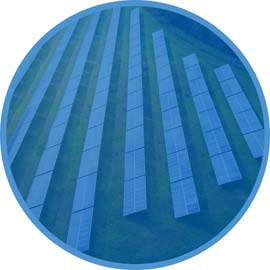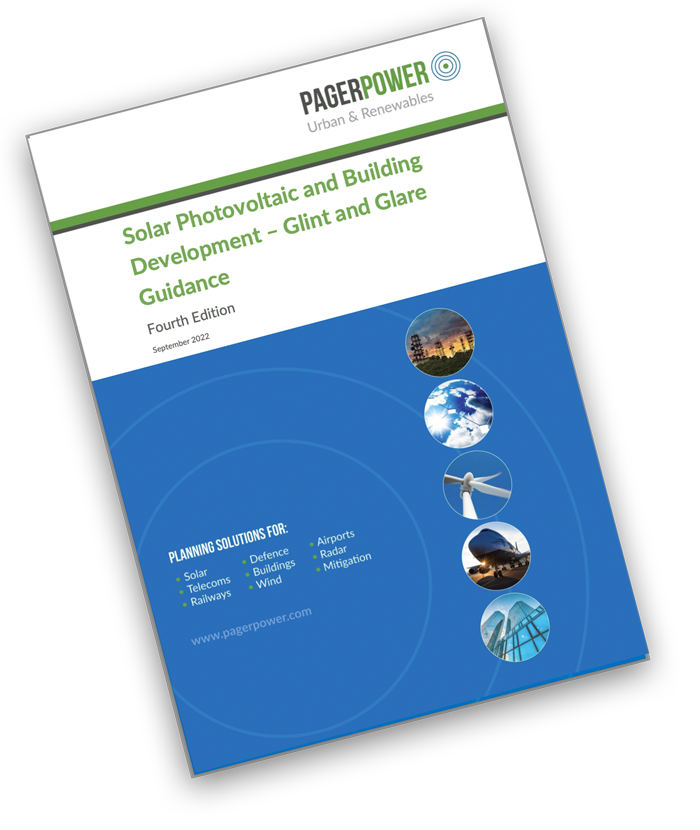Why assess glint and glare?
Solar glint and glare i.e. reflected sunlight from shiny surfaces can affect safety and residential amenity in surrounding areas. Glint and glare assessments are routinely required for solar photovoltaic developments all around the world.
Failure to address potential issues can result in refusal of permission to develop a project and/or increase local opposition to the development.
Who is concerned about glint and glare?
Concerns can come from a variety of places. Requirements for formal assessment most often come from stakeholders with infrastructure in the area (such as airports and railway operators), local or national authorities (such as planning authorities and highway agencies) and local residents. Pager Power offer assessments tailored to the relevant concerns, an overview of the most common options are presented below.
Aviation
Airports in the area surrounding a solar photovoltaic development routinely require technical assessment in the interest of safety. The key receptors pertaining to airports are:
- Personnel in the air traffic control tower.
- Pilots of aircraft on final approach to the runways.
In some cases, modelling of additional receptors is required. This can include pilots of aircraft in the visual circuit, pilots of aircraft on taxiways and helicopter pilots.
Impacts on aviation receptors are determined based on whether reflections are predicted, the relative position of the reflection to the observer and the reflection intensity.
Impacts on railway receptors are determined based on whether reflections are predicted and the relative position of the reflection to the observer.
Assessments are conducted in accordance with industry best practice and applicable guidance.
Roads and Dwellings
Road users and observers in residential dwellings surrounding a solar photovoltaic development routinely require technical assessment in the interest of safety and residential amenity respectively. The key receptors are:
- Road users on regional or national roads within 1 km of a solar panel.
- Residential properties within 1 km of a solar panel.
In some cases, modelling of additional receptors is required. This can include public rights of way or other areas that are likely to be occupied by sensitive receptors.
Impacts on road users are determined based on whether reflections are predicted and the relative position of the reflection to the observer.
Impacts on dwelling occupants also consider the glare duration – because the observers in this case are static.
Assessments are conducted in accordance with industry best practice and applicable guidance.
Railway Operators
Railway operators in the area surrounding a solar photovoltaic development routinely require technical assessment in the interest of safety. The key receptors pertaining to railway operations are:
- Train drivers on railway lines adjacent to proposed solar panels.
- Railway signals adjacent to proposed solar panels.
What are the benefits of a Pager Power Glint and Glare Assessment?
Pager Power’s glint and glare assessments are comprehensive, covering all technical aspects that are regularly required. For all receptors, the dates and times at which effects could be experienced are quantified. For approaching pilots, the relevant intensity calculations are undertaken in accordance with the industry standard methodology.
All Pager Power reports are designed to be:
- Comprehensive – covering all the relevant aspects for each individual proposed development.
- Up-to-date with reference to current guidelines from the relevant bodies and recent industry developments.
- Understandable to non-experts and experts alike.
Pager Power has undertaken glint and glare assessments worldwide including Europe, India, Australia, and South Africa. The company has produced its own guidance document in coordination with developers and stakeholders with a view to standardising an assessment methodology. The guidance was first published in 2017 and is now in its fourth edition > .
What does a Pager Power Glint and Glare Assessment cover?
Guidance
A review of the applicable guidance and industry best-practice as it applies to the development in question is presented.
Identification of Receptors
The relevant receptors will be identified based on the site’s location, size and relevant consultation/responses received to date.
Technical Modelling
The dates, times and duration of potential effects are quantified. Where appropriate, intensity calculations are undertaken.
Results Interpretation
The technical results are interpreted in the context of the available guidance and industry best practice.
Mitigation Overview
Discussion of ways to reduce or remove impacts are presented where appropriate.
Recommendation
Recommended next steps to progress the development are defined.
If you’d like to discuss this service with a member of our team, please get in touch.

“In recent years we have engaged Pager Power on glint and glare studies for solar farms in the UK and Ireland. Prior to that, Pager Power undertook air-safeguarding and telecoms assessments for wind farm proposals, including resolving specific technical issues with particular airports or protected zones.
We have always found your professional services to be of good quality, efficient and friendly. Services have been delivered to scope and to budget, and your technical specialist knowledge on air-safeguarding and glint / glare have always been reliable.”
Michael Philips
Principal Consultant, Dulas


How can we help you today?



THE SECTORS WE SERVE









